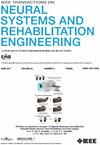一个mri兼容系统,用于表征与行走相关的足底体感刺激的棘上处理。
IF 4.8
2区 医学
Q2 ENGINEERING, BIOMEDICAL
IEEE Transactions on Neural Systems and Rehabilitation Engineering
Pub Date : 2025-03-28
DOI:10.1109/TNSRE.2025.3555852
引用次数: 0
摘要
脚底是走路时唯一与地面直接接触的部位。脚底的机械感受器不断获得体感信息(例如,地面反作用力),并将其传递给脊柱和棘上神经网络。通过激活棘上区域,及时准确地处理这些信息,对行走的调节至关重要。然而,我们对与行走相关的椎上体感处理知之甚少。利用MRI表征与步行相关的体感输入的椎上反应是具有挑战性的,因为个体在MRI扫描期间需要保持不动。因此,我们开发了一种刺激系统,模拟在地面行走的每一步中所经历的足底压力变化的幅度和时间,而不会引起明显的头部运动。在验证模拟的有效性和可靠性的研究中,7名年轻人完成了两次8米步行试验。使用压力鞋垫记录行走过程中每一步脚底压力的时间变化,并用于对系统的运动进行编程。结果表明,刺激具有较高的效度和信度(rho=0.94~0.98, p本文章由计算机程序翻译,如有差异,请以英文原文为准。
An MRI-Compatible System for Characterizing Supraspinal Processing of Walking-Related Foot-Sole Somatosensory Stimulation
Foot soles are the only part in direct contact with the ground during walking. The mechanoreceptors on foot soles continuously obtain somatosensory information (e.g., ground reaction forces) that is delivered to spinal and supraspinal networks. The timely and accurate supraspinal processing of such information, which can be captured by the activation of the supraspinal regions, is critical to the regulation of walking. However, little is known about supraspinal somatosensory processing related to walking. Characterizing the supraspinal response to walking-related somatosensory inputs using MRI is challenging, because individuals are required to stay motionless during MRI scan. We thus developed a stimulation system that simulates the amplitude and timing of foot-sole pressure changes experienced during each step of overground walking, without inducing significant head motion. In the study to examine its validity and reliability of simulation, seven younger adults completed two trials of eight-meter walking. The temporal changes of foot-sole pressure of each step during walking were recorded using a pressure insole and used to program the motion of the system. The results indicated high validity and reliability of the stimulation (rho $= 0.94\sim 0.98$ , p<0.0001). Phantom imaging test revealed that the signal-to-noise ratio of the MR image when the system working was similar to when the system was off, suggesting excellent MRI compatibility. Finally, block-designed test indicated that, compared to rest, multiple supraspinal regions (e.g., postcentral gyrus) were activated (p<0.005) by foot-sole stimulation. This MRI-compatible system provides a novel approach to characterizing the supraspinal sensorimotor control of walking via MRI.
求助全文
通过发布文献求助,成功后即可免费获取论文全文。
去求助
来源期刊
CiteScore
8.60
自引率
8.20%
发文量
479
审稿时长
6-12 weeks
期刊介绍:
Rehabilitative and neural aspects of biomedical engineering, including functional electrical stimulation, acoustic dynamics, human performance measurement and analysis, nerve stimulation, electromyography, motor control and stimulation; and hardware and software applications for rehabilitation engineering and assistive devices.

 求助内容:
求助内容: 应助结果提醒方式:
应助结果提醒方式:


